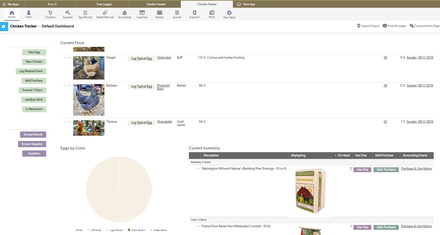Hi Maria, fine looking flock! They're so cute at that fluffy stage. And I love your watering system-- what a great way to keep little playful chicks from spilling water all over everything and soaking the bedding!
Here's a few more details about each piece.
The most important thing to look for when looking for readers and scanners is to look at the frequency of them, and make sure they match. There's basically low frequency and high frequency. I got the low frequency (125KHz) because they don't need batteries and are a lot cheaper. The drawbacks are that they need to be real close to the scanner to be read, and information-wise, only hold a number, and can't be reprogrammed. Since this was connecting to quick base, that's not a big deal. There is also low-frequency RFID that operates at 134.2KHz, that would allow you to write information to, and some of which are compatible with the chips that are put in pets for identification, and hold more information. I stuck with the cheap 125KHz ones, because of cost, and all Quick Base needs to know is a unique value to link it to other information.
Another really important thing is to pay attention to is the size of the band that goes around the chicken's leg. - specifically, the opening, to make sure it's big enough to fit around the chicken's leg comfortably. My chickens are full-size, and breeds that are on the larger side, so the bands with an inner diameter of about 17-19mm (11/16"-3/4") fit pretty well for them. There were a lot for sale that were very small, made I think for racing pigeons or something, so make sure that the inner diameter is not too small. There are plenty of sellers selling these things on AliExpress where I got them, so just verify that the frequency and the size are what you need before buying. Generally, they're sold in lots of varying size. I ended up getting a lot of 100, for about $27. Smaller lots make the price per each a bit more, but I figured having extra ones to play around with couldn't hurt either.
As for the readers, the one in the picture I posted is very common all over the place, and is about as basic as it gets. It says "Windows" on it, but works with the Linux that is installed on the Raspberry Pi too. It's USB, which makes connecting it to the Pi easy, and was just over $5 on AliExpress. The same exact one sells for as much as $20 in many other places, so shop around until you find a good deal. There are larger scanners out there, which are about 9" x 9", but for some reason are about $170. I've seen some YouTube videos of people making their own, but it gets to be an electronics project very quickly, so the simple USB was good to start with and proof-of-concept it.
The Raspberry Pi Zero W is the brains of the operation. It's about $15 by itself, or there are kits on Amazon with a power cable and case for about $26. Make sure it's a Pi Zero W, the W means built-in WiFi, which is important because it only has 2 micro USB ports that are used up by the power cable and the RFID scanner. On the Pi Zero is standard Raspian Jesse operating system. I'm not so good at Linux yet, so I chose Jesse, which has a GUI like windows, which made setup easier. I wrote a simple Python script that when a number is typed in, it goes to my Quick Base account using the API and adds a record. It doesn't open a browser window when it does it, just loops back and waits for another number to be entered. Since it was running out in the barn with no keyboard or monitor, there was a setup command to do in Linux to make the python script run at startup. If you were to plug a monitor into it while it runs, you'd see a window with a blinking cursor just sitting there, awaiting input. Probably not the most elegant solution, but it works. I also programmed one of the RFID tags to run a shutdown command if it's scanned, to safely turn off the Raspberry Pi if it needs to be moved.
This is what I did with mine-- it was pretty much put together as cheap as possible to test the concept. Changes or more additions could be useful, but there are some trade-offs, so at this point if I were to do anything different it would be a bigger scanner. But for the cost of them, as well as the extra electronic wiring work involved, I'm still looking at other options. For a start though, this has been a pretty good setup.
Hope that helps, I'm not sure about the policy here of posting direct links so I didn't link to anything specific, but the RFID bands and reader was from AliExpress and the Pi was from Amazon.
------------------------------
Steve Davidson
------------------------------
